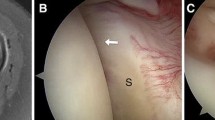Abstract
Objective
To determine the accuracy of MR imaging for the evaluation of the subscapularis tendon as well as define imaging findings that will increase accuracy.
Materials and methods
Retrospective review of the MR and operative (OR) reports of 286 patients was conducted and reviewed for the presence/degree (partial (PT)/full-thickness (FT)) of tearing; only PT articular tears were included. The presence of a supraspinatus tear and time interval between surgery and MRI were also documented. All of the PT tears called on MRI were also reviewed to see if there was a statistically significant association between certain imaging characteristics and the presence of a tear in surgery. Statistical analysis included 95 % confidence intervals, Fisher’s exact, and exact Mann–Whitney tests.
Results
A total of 244 patients were included in the study with a total of 25 subscapularis tears, 16 PT and nine FT, and 219 intact tendons in arthroscopy; 20/25 tears and 200 intact tendons were diagnosed correctly on MRI, resulting in sensitivity of 80 %, specificity of 91 %, accuracy of 90 %, positive predictive value of 51 %, and negative predictive value of 98 %. There was a significant association between the presence of a PT tear during arthroscopy and fluid-like signal within the tendon on more than one imaging plane (p < 0.001) with an accuracy of 90 %.
Conclusions
This study reflects a musculoskeletal radiology section’s experience with the diagnosis of subscapularis tendon pathology, demonstrating that MRI could be used to accurately evaluate the subscapularis tendon. An understanding of certain imaging pitfalls and the presence of fluid-like signal on multiple imaging planes should increase the diagnostic accuracy of the radiologist evaluating the subscapularis tendon for the presence of a tear.




Similar content being viewed by others
References
Bigliani LU, Kelkar R, Flatow EL, et al. Glenohumeral stability: biomechanical properties of passive and active stabilizers. Clin Orthop Relat Res. 1996;330:13–30.
Abboud JA, Soslowsky LJ. Interplay of the static and dynamic restraints in glenohumeral instability. Clin Orthop Relat Res. 2002;400:48–57.
Halder A, Zobitz ME, Schultz F, et al. Structural properties of the subscapularis tendon. J Orthop Res. 2000;18:829–34.
Gerber C, Krushell RJ. Isolated rupture of the tendon of the subscapularis muscle. Clinical features in 16 cases. J Bone Jt Surg Br. 1991;73:389–94.
Li XX, Schweitzer ME, Bifano JA, Lerman J, Manton GL, El- Noueam KI. MR evaluation of subscapularis tears. J Comput Assist Tomogr. 1999;23:713–7.
Deutsch A, Altchek DW, Veltri DM, Potter HG, Warren RF. Traumatic tears of the subscapularis tendon. Clinical diagnosis, magnetic resonance imaging findings, and operative treatment. Am J Sports Med. 1997;25:13–22.
Neviaser RJ, Neviaser TJ, Neviaser JS. Concurrent rupture of the rotator cuff and anterior dislocation of the shoulder in the older patient. J Bone Joint Surg Am. 1988;70:1308–11.
Simank HG, Dauer G, Schneider S, et al. Incidence of rotator cuff tears in shoulder dislocations and results of therapy in older patients. Arch Orthop Trauma Surg. 2006;126:235–40.
Wright JM, Heavrin B, Hawkins RJ, et al. Arthroscopic visualization of the subscapularis tendon. Arthroscopy. 2001;17:677–84.
Morag Y, Jamadar DA, Miller B, et al. The subscapularis: anatomy, injury, and imaging. Skeletal Radiol. 2011;40:255–69.
Foad A, Wijdicks CA. The accuracy of magnetic resonance imaging and magnetic resonance arthrogram versus arthroscopy in the diagnosis of subscapularis tendon injury. Arthroscopy. 2012;28:636–41.
Pfirrmann CWA, Zanetti M, Weishaupt D, Gerber C, Hodler J. Subscapularis tendon tears: detection and grading at MR arthrography. Radiology. 1999;213:709–14.
Tung GA, Yoo DC, Levine SM, Brody JM, Green A. Subscapularis tendon tear: primary and associated signs on MRI. J Comput Assist Tomogr. 2001;25:417–24.
Adams CR, Schoolfield JD, Burkhart SS. Accuracy of preoperative magnetic resonance imaging in predicting a subscapularis tendon tear based on arthroscopy. Arthroscopy. 2010;26:1427–33.
Adams CR, Brady PC, Koo SS, Narbona P, Arrigoni P, Karnes GJ, et al. A systematic approach for diagnosing subscapularis tendon tears with preoperative magnetic resonance imaging scans. Arthroscopy. 2012;28:1592–600.
Conflict of interest
No conflict of interest.
Disclosure
No financial disclosures.
Author information
Authors and Affiliations
Corresponding author
Rights and permissions
About this article
Cite this article
Gyftopoulos, S., O’Donnell, J., Shah, N.P. et al. Correlation of MRI with arthroscopy for the evaluation of the subscapularis tendon: a musculoskeletal division’s experience. Skeletal Radiol 42, 1269–1275 (2013). https://doi.org/10.1007/s00256-013-1669-5
Received:
Revised:
Accepted:
Published:
Issue Date:
DOI: https://doi.org/10.1007/s00256-013-1669-5




